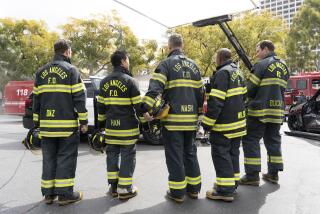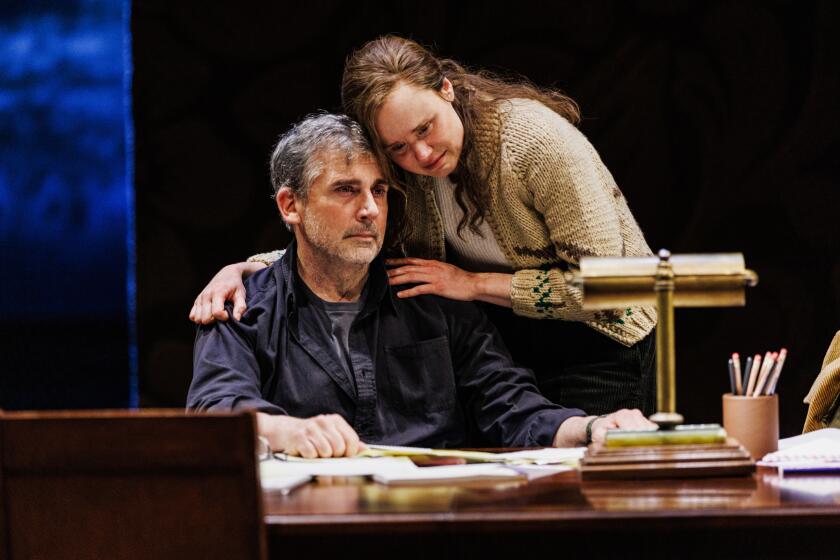Unique LAPD Detail Walks the Art Theft Beat
Former professional football player Sammie Archer sauntered into Christie’s auction house in Beverly Hills and informed the manager he wanted to sell a Picasso. He had paid $60,000 for it, he told her, was going through a divorce and needed cash without his wife knowing.
As they talked, Archer mentioned that “it’s a really ugly painting.”
In the world of high art, such a statement--more than just evidence of aesthetic ignorance-- was the whisper of a possible crime.
Nathalie Kereszi didn’t know that the 1937 work--not a painting, in fact, but an ink drawing--titled “Faune” and worth $100,000, was wrapped in a shirt in the trunk of Archer’s BMW. But she did sense something was wrong, and within minutes police arrested Archer, who had stolen the work from Hollywood producer Peter Guber.
Archer, who pleaded guilty two weeks ago, is scheduled to be sentenced Sept. 28.
For LAPD Det. Don Hrycyk, the arrest of Guber’s chauffeur was another victory in one of the art-theft capitals of the United States.
Often well-off, they are “thugs in nice clothes,” said Hrycyk.
For eight years, the detective has been an investigator--sometimes the only one--for the Los Angeles Police Department’s Art Theft Detail, the only full-fledged municipal art investigative unit in the United States. In those years, he has had seven partners, who no sooner had settled into the job than they moved to other details.
Nevertheless, the art detail has recovered more than $46 million in stolen art, according to the LAPD.
The quest has been helped by a Web site the detail set up in 1999 (https://https://lapdonline.org/art_theft/) which lists stolen art, collectibles, heirlooms, jewelry and other valuables. It was a glance at the site that prompted Kereszi to alert Christie’s security manager, who called Hrycyk.
A first edition “Superman” comic book, Charlie Brown animation cels and even fossils have joined Picassos and Goyas among pilfered art listed on the site. Celebrities such as Della Reese have sought the art detail’s aid. Even Angelyne, that omnipresent, bosomy billboard L.A. maven, has contacted art detectives, after dozens of paintings she said were worth about $1 million were stolen. (Many of the paintings touch upon a similar theme: a naked Angelyne.)
The cases that have touched Hrycyk the most have not involved celebrities or famous victims. They involve people like Luis Magin.
In Colombia, Magin had made a name for himself as a painter. He hoped to do the same when he came to the United States in 1987. But in 1995, 25 paintings spanning three decades were stolen from a van after an exhibition in downtown L.A.
“I fell into a terrible depression. It was an artistic knockout,” he said. “I stopped looking for both glory or money.”
For six years, Magin stopped creating his vivid paintings that eschewed European influences in favor of what he said were purely native American aesthetics. His dreams of conquering America faded. He fell into a financial funk, and moved with his wife into a North Hollywood apartment to live with one of his daughters. He rarely came out of his home and lost touch with other people.
Then, earlier this year, someone saw pictures of three paintings he owned, and hadn’t known were stolen, on Hrycyk’s Web site. He called, and the three works were returned to the artist. The effect on Magin was dramatic, his wife of 29 years said.
“It gave him hope and faith. He became animated and soon he was promising good news ahead,” Irma Perez said. Three months ago, Magin resumed painting.
“Finding those paintings gave me life,” Magin said.
In 1994, $100,000 worth of ornate Japanese sash holders (netsukes) were stolen from the home of an elderly woman. They were so prized, Hrycyk said, that she and her husband once had lent them to the L.A. Museum of Art. As Hrycyk took a crime report, he caught the woman staring at a bare wall, where a small painting of a child’s face had hung.
“It was a cheap painting, but it had been given to her by her [since] deceased husband while on vacation in the Caribbean,” Hrycyk said. “She had lost $100,000 worth of art, but she was most upset that she lost that little painting of a child’s face.”
None of that art has been found.
More often than not, Hrycyk said, lost art has a greater sentimental than monetary value.
“People get attached to art,” he said. “Sometimes the monetary value doesn’t matter.”
The reverse was true, however, for the things stolen from Guber’s Bel-Air home either Dec. 28 or 29. “Faune,” three Picasso plates, a bronze sculpture of an African elephant and a Tiffany lamp valued at $75,000 disappeared. The total loss was then considered $205,000, though the lamp sold for $275,000, Hrycyk said.
Although Sammie Archer, charming and genial, had almost convinced Hrycyk during an interview in January he was not involved, he eventually skipped on a polygraph test.
A talented receiver for the University of Oregon, Archer fell short of the NFL. He played for the Sacramento Surge of the World League of American Football.
Before working for Guber, he worked for actor Chevy Chase. A church going man, Archer took Bible classes and even counseled married couples, his wife Julie Archer said.
He was a good and affectionate husband and father, and honest, she thought. He came from a tough stretch of Stockton, and most of his seven siblings had spent substantial time in the penal system, she said. But not Sammie.
“He always aspired to be the one who made it. The one who saved his family,” Julie Archer said.
Working for celebrities, Archer had access to fast cars, and his wife thought, to fast women. “He was a different person,” she said. “Sammie’s a good man, really. I think he just gave in to temptation.”
On the day he took Guber’s art, Archer, 35, tried to kick out windows to make it appear that a stranger had robbed the house, Hrycyk said. The laminated glass, kicked from inside, merely bulged and cracked. “That was dumb,” Hrycyk said.
At Christie’s, Archer told a manager that he didn’t bring “Faune” with him because he thought the auction house might take pictures and sell the prints. It was a strange thing to worry about, Christie’s officials thought.
At one point, Archer said he would take a check for $60,000, the amount he claimed to have paid for “Faune,” and let Christie’s take the proceeds from any auction. The offer struck Christie’s staff as bizarre. Then there was Archer’s characterization of “Faune” as “really ugly.”
“If you’re going to be selling an original Picasso for consignment to a major auction house, you’re going to extol the virtues and not denigrate it,” Hrycyk said.
As Hrycyk crafted a game plan over the phone, Christie’s staff members kept Archer talking. Beverly Hills patrol officers took positions as the L.A. detective drove to the auction house.
When a handcuffed Archer saw Hrycyk walk into Christie’s, he recognized the detective who had interviewed him and others months earlier. Archer half-smiled at the detective.
Hrycyk said, “Hi, Sammie.”
“He knew the cat was out of the bag,” Hrycyk said later.
More to Read
The biggest entertainment stories
Get our big stories about Hollywood, film, television, music, arts, culture and more right in your inbox as soon as they publish.
You may occasionally receive promotional content from the Los Angeles Times.







